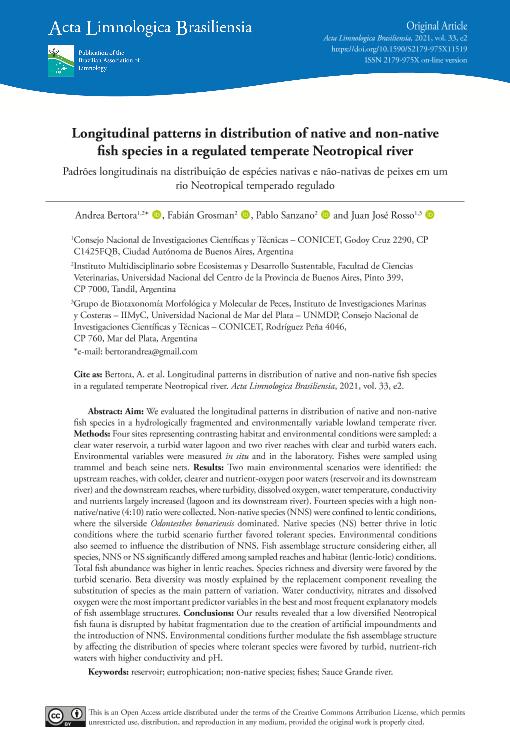Artículo
Longitudinal patterns in distribution of native and non-native fish species in a regulated temperate Neotropical river
Título:
Padrões longitudinais na distribuição de espécies nativas e não-nativas de peixes em um rio Neotropical temperado regulado
Fecha de publicación:
01/2021
Editorial:
Associação Brasileira de Limnologia
Revista:
Acta Limnologica Brasiliensia
ISSN:
0102-6712
e-ISSN:
2179-975X
Idioma:
Inglés
Tipo de recurso:
Artículo publicado
Clasificación temática:
Resumen
Aim: We evaluated the longitudinal patterns in distribution of native and non-native fish species in a hydrologically fragmented and environmentally variable lowland temperate river. Methods: Four sites representing contrasting habitat and environmental conditions were sampled: a clear water reservoir, a turbid water lagoon and two river reaches with clear and turbid waters each. Environmental variables were measured in situ and in the laboratory. Fishes were sampled using trammel and beach seine nets. Results: Two main environmental scenarios were identified: the upstream reaches, with colder, clearer and nutrient-oxygen poor waters (reservoir and its downstream river) and the downstream reaches, where turbidity, dissolved oxygen, water temperature, conductivity and nutrients largely increased (lagoon and its downstream river). Fourteen species with a high non-native/native (4:10) ratio were collected. Non-native species (NNS) were confined to lentic conditions, where the silverside Odontesthes bonariensis dominated. Native species (NS) better thrive in lotic conditions where the turbid scenario further favored tolerant species. Environmental conditions also seemed to influence the distribution of NNS. Fish assemblage structure considering either, all species, NNS or NS significantly differed among sampled reaches and habitat (lentic-lotic) conditions. Total fish abundance was higher in lentic reaches. Species richness and diversity were favored by the turbid scenario. Beta diversity was mostly explained by the replacement component revealing the substitution of species as the main pattern of variation. Water conductivity, nitrates and dissolved oxygen were the most important predictor variables in the best and most frequent explanatory models of fish assemblage structures. Conclusions: Our results revealed that a low diversified Neotropical fish fauna is disrupted by habitat fragmentation due to the creation of artificial impoundments and the introduction of NNS. Environmental conditions further modulate the fish assemblage structure by affecting the distribution of species where tolerant species were favored by turbid, nutrient-rich waters with higher conductivity and pH.
Palabras clave:
EUTROPHICATION
,
FISHES
,
NON-NATIVE SPECIES
,
RESERVOIR
,
SAUCE GRANDE RIVER
Archivos asociados
Licencia
Identificadores
Colecciones
Articulos(CCT - TANDIL)
Articulos de CTRO CIENTIFICO TECNOLOGICO CONICET - TANDIL
Articulos de CTRO CIENTIFICO TECNOLOGICO CONICET - TANDIL
Citación
Bertora, Andrea; Grosman, Fabián; Sanzano, Pablo Miguel; Rosso, Juan Jose; Longitudinal patterns in distribution of native and non-native fish species in a regulated temperate Neotropical river; Associação Brasileira de Limnologia; Acta Limnologica Brasiliensia; 33; 1-2021; 1-20
Compartir
Altmétricas




